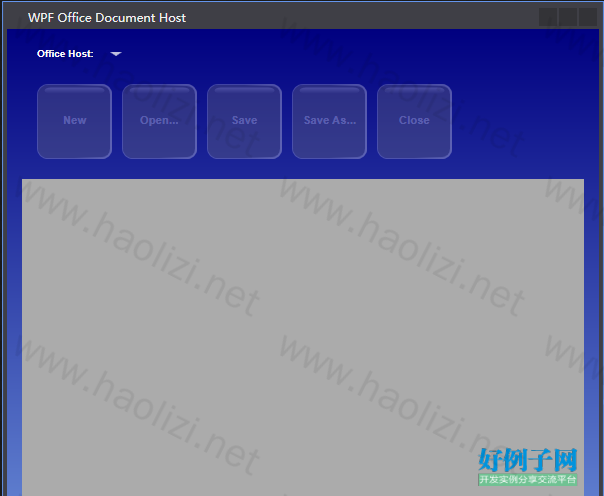实例介绍
【实例简介】
【实例截图】

【核心代码】
using System;
using System.Collections.Generic;
using System.Text;
using System.Windows;
using System.Windows.Controls;
using System.Windows.Data;
using System.Windows.Documents;
using System.Windows.Input;
using System.Windows.Media;
using System.Windows.Media.Imaging;
using System.Windows.Shapes;
using System.Windows.Forms;
using AxDSOFramer;
using System.Xml;
using System.ComponentModel;
using System.Windows.Threading;
namespace OfficeDocumentHost
{
public partial class DocumentWindow : Window
{
public DocumentWindow()
{
InitializeComponent();
}
#region CloseDocument
public static RoutedUICommand CloseDocument = new RoutedUICommand("Close Document", "CloseDocument", typeof(DocumentWindow));
private void CloseDocumentExecuted(object sender, ExecutedRoutedEventArgs e)
{
// if this were a real app, we might prompt the user to save unsaved changes...
// but we're lazy so we'll just ask if they really want to close the current document
if (System.Windows.MessageBox.Show("Do you really want to close '" _documentName "'?", "Close Document?",
MessageBoxButton.YesNo, MessageBoxImage.Question, MessageBoxResult.Yes) == MessageBoxResult.Yes)
{
try
{
framer.Close();
_documentName = string.Empty;
Title = "WPF Office Document Host";
}
catch (Exception) { }
}
}
private void CanCloseDocument(object sender, CanExecuteRoutedEventArgs e)
{
e.CanExecute = !string.IsNullOrEmpty(_documentName);
}
#endregion
#region CreateDocument
public static RoutedUICommand CreateDocument = new RoutedUICommand("Create Document", "CreateDocument", typeof(DocumentWindow));
private void CreateDocumentExecuted(object sender, ExecutedRoutedEventArgs e)
{
try
{
framer.CreateNew(OfficeProgram.SelectedValue as string);
_documentName = (OfficeProgram.SelectedItem as XmlElement).Attributes["UntitledDocumentName"].Value;
Title = "WPF Office Document Host - " _documentName;
_isNewDocument = true;
}
catch (Exception)
{
System.Windows.MessageBox.Show("Unable to create document.",
"Create Document Failed", MessageBoxButton.OK, MessageBoxImage.Asterisk, MessageBoxResult.OK);
}
}
private void CanCreateDocument(object sender, CanExecuteRoutedEventArgs e)
{
e.CanExecute = string.IsNullOrEmpty(_documentName);
}
#endregion
#region OpenDocument
public static RoutedUICommand OpenDocument = new RoutedUICommand("Open Document", "OpenDocument", typeof(DocumentWindow));
private void OpenDocumentExecuted(object sender, ExecutedRoutedEventArgs e)
{
// we're already linking with WinForms, so for simplicity, we'll just
// leverage the WinForms OpenFileDialog
if (_openFileDialog == null)
{
_openFileDialog = new OpenFileDialog();
_openFileDialog.Filter = "Microsoft Office Files|*.doc;*.docx;*.docm;*.rtf;*.xls;*.xlsx;*.xlsm;*.xlsb;*.csv;*.ppt;*.pptx;*.pptm;*.vsd;*.vdx|All Files|*.*";
}
DialogResult result = _openFileDialog.ShowDialog();
if (result == System.Windows.Forms.DialogResult.OK)
{
try
{
framer.Select();
framer.Open(_openFileDialog.FileName);
_documentName = framer.DocumentName;
Title = "WPF Office Document Host - " _documentName;
_isNewDocument = false;
}
catch (Exception)
{
System.Windows.MessageBox.Show("Unable to open document: " _openFileDialog.FileName,
"Open Failed", MessageBoxButton.OK, MessageBoxImage.Asterisk, MessageBoxResult.OK);
}
}
}
private void CanOpenDocument(object sender, CanExecuteRoutedEventArgs e)
{
// require user to close current document before opening a new one
e.CanExecute = string.IsNullOrEmpty(_documentName);
}
#endregion
#region SaveDocument
public static RoutedUICommand SaveDocument = new RoutedUICommand("Save Document", "SaveDocument", typeof(DocumentWindow));
private void SaveDocumentExecuted(object sender, ExecutedRoutedEventArgs e)
{
try
{
framer.Save();
}
catch (Exception ex)
{
System.Windows.MessageBox.Show("Unable to save document '" _documentName "'. " ex.Message,
"Save Document Failed", MessageBoxButton.OK, MessageBoxImage.Asterisk, MessageBoxResult.OK);
}
}
private void CanSaveDocument(object sender, CanExecuteRoutedEventArgs e)
{
e.CanExecute = !string.IsNullOrEmpty(_documentName) && !_isNewDocument;
}
#endregion
#region SaveDocumentAs
public static RoutedUICommand SaveDocumentAs = new RoutedUICommand("Save Document As", "SaveDocumentAs", typeof(DocumentWindow));
private void SaveDocumentAsExecuted(object sender, ExecutedRoutedEventArgs e)
{
// we're already linking with WinForms, so for simplicity, we'll just
// leverage the WinForms SaveFileDialog
if (_saveFileDialog == null)
{
_saveFileDialog = new SaveFileDialog();
_saveFileDialog.OverwritePrompt = true;
}
_saveFileDialog.FileName = _documentName;
_saveFileDialog.DefaultExt = System.IO.Path.GetExtension(_documentName);
DialogResult result = _saveFileDialog.ShowDialog();
if (result == System.Windows.Forms.DialogResult.OK)
{
try
{
framer.Save(_saveFileDialog.FileName, true, null, null);
}
catch (Exception ex)
{
System.Windows.MessageBox.Show("Unable to save document as '" _saveFileDialog.FileName "'. " ex.Message,
"Save Document Failed", MessageBoxButton.OK, MessageBoxImage.Asterisk, MessageBoxResult.OK);
}
}
}
private void CanSaveDocumentAs(object sender, CanExecuteRoutedEventArgs e)
{
e.CanExecute = !string.IsNullOrEmpty(_documentName);
}
#endregion
private void InitializeFramerControl(object sender, RoutedEventArgs e)
{
// We set certain DSO Framer properties in response to
// the Loaded event because we need to ensure that the
// framer control is connected to its parent (added to
// its Controls collection) prior to setting properties
// like Titlebar, Menubar, etc. Attempting to set these
// properties before the control is parented will result
// in an InvalidActiveXStateException.
framer.Menubar = false;
framer.Titlebar = false;
}
private void DocumentOpened(object sender, _DFramerCtlEvents_OnDocumentOpenedEvent e)
{
// When a new document is opened, update the selection of the combobox
// to match the document type. The following approach is not necessarily
// accurate since it makes assumptions on the document type based on its
// file extension. It also assumes that the office programs are listed
// alphabetically in the OfficePrograms XmlDataProvider. But its good
// enough for demo purposes.
switch (System.IO.Path.GetExtension(e.file).ToLower())
{
case ".xls":
case ".xlsx":
case ".xlsm":
case ".xlsb":
case ".csv":
OfficeProgram.SelectedIndex = 0;
break;
case ".ppt":
case ".pptx":
case ".pptm":
OfficeProgram.SelectedIndex = 1;
break;
case ".vsd":
case ".vdx":
OfficeProgram.SelectedIndex = 2;
break;
case ".doc":
case ".docx":
case ".docm":
case ".rtf":
OfficeProgram.SelectedIndex = 3;
break;
}
}
private void SaveCompleted(object sender, _DFramerCtlEvents_OnSaveCompletedEvent e)
{
_isNewDocument = false;
_documentName = e.docName;
Title = "WPF Office Document Host - " _documentName;
}
private void WindowClosing(object sender, CancelEventArgs e)
{
if (!string.IsNullOrEmpty(_documentName))
{
if (System.Windows.MessageBox.Show("Do you really want to close '" _documentName "'?", "Close Document?",
MessageBoxButton.YesNo, MessageBoxImage.Question, MessageBoxResult.Yes) != MessageBoxResult.Yes)
{
e.Cancel = true;
}
}
}
private void WindowSizeChanged(object sender, SizeChangedEventArgs e)
{
// We need to reactivate the ActiveX control after the window size changes.
// There are probably lots of other places where we need to reactivate the
// control, but we're lazy.
_isFramerDirty = true;
this.Dispatcher.BeginInvoke(DispatcherPriority.Background, (DispatcherOperationCallback)delegate(object o)
{
if (framer != null && _isFramerDirty)
{
framer.Activate();
}
return null;
}, null);
framer.Activate();
}
private string _documentName = string.Empty;
private bool _isNewDocument = false;
private bool _isFramerDirty = false;
private OpenFileDialog _openFileDialog = null;
private SaveFileDialog _saveFileDialog = null;
}
}
好例子网口号:伸出你的我的手 — 分享!
网友评论
小贴士
感谢您为本站写下的评论,您的评论对其它用户来说具有重要的参考价值,所以请认真填写。
- 类似“顶”、“沙发”之类没有营养的文字,对勤劳贡献的楼主来说是令人沮丧的反馈信息。
- 相信您也不想看到一排文字/表情墙,所以请不要反馈意义不大的重复字符,也请尽量不要纯表情的回复。
- 提问之前请再仔细看一遍楼主的说明,或许是您遗漏了。
- 请勿到处挖坑绊人、招贴广告。既占空间让人厌烦,又没人会搭理,于人于己都无利。
关于好例子网
本站旨在为广大IT学习爱好者提供一个非营利性互相学习交流分享平台。本站所有资源都可以被免费获取学习研究。本站资源来自网友分享,对搜索内容的合法性不具有预见性、识别性、控制性,仅供学习研究,请务必在下载后24小时内给予删除,不得用于其他任何用途,否则后果自负。基于互联网的特殊性,平台无法对用户传输的作品、信息、内容的权属或合法性、安全性、合规性、真实性、科学性、完整权、有效性等进行实质审查;无论平台是否已进行审查,用户均应自行承担因其传输的作品、信息、内容而可能或已经产生的侵权或权属纠纷等法律责任。本站所有资源不代表本站的观点或立场,基于网友分享,根据中国法律《信息网络传播权保护条例》第二十二与二十三条之规定,若资源存在侵权或相关问题请联系本站客服人员,点此联系我们。关于更多版权及免责申明参见 版权及免责申明



支持(0) 盖楼(回复)